Experienced and experiencing teacher Inspire article
Vasiliki Kioupi has always run science experiments with her students. Now she is also testing various pedagogical methods in her classroom and is moving towards teaching the teachers.
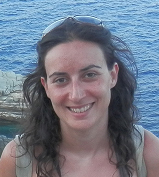
Image courtesy of
Vasiliki Kioupi
Most teachers do experiments with their students, not on them – unless, like Vasiliki Kioupi, they spent the past year working for the Varvakeio Model Experimental School (VMES)w1in Athens, Greece.
With her large smile and enthusiastic eyes, Vasiliki has never used a scalpel on anybody in her classroom; instead, she used the school as a testing ground for various pedagogical methods, such as enquiry-based learning or the story-telling teaching model.
“These methods are still new in Greece, so the feedback we give to the science advisors goes to the Greek ministry of education, and is then hopefully used to improve the national curriculum,” she explains.
Enquiry-based learning
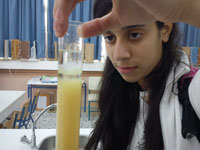
function: laboratory work
Image courtesy of Vasiliki
Kioupi
Vasiliki initially trained as a biologist, then earned a master’s degree in science education before embarking on her career as a biology, chemistry and physics teacher. As a scientist, she believes in observing her surroundings, asking questions and learning from her own experiments – so the enquiry-based learning method has always been a natural fit for her lessons.
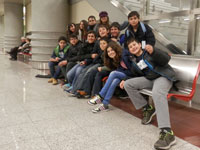
group: sustainable
transportation ‘Take the
underground to go to school’
campaign
Image courtesy of Vasiliki
Kioupi
Even before her time at the VMES, Vasiliki set up interactive lesson plans in which students were encouraged to actively investigate scientific concepts. As a biology teacher, she put a lot of emphasis on genetics and turned towards the worldwide web to find interesting information that could be used to motivate her students: web-based biological databases offer free access to some very comprehensive and important sets of data. From DNA to proteins, from sequences to structures and interactions – it is all there, provided you know how and where to look. Despite their availability, these tools were – and still are – not being used by Greek teachers, so Vasiliki found herself isolated.
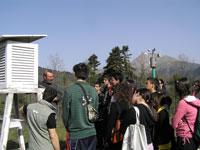
station to understand how
data on temperature and
humidity are collected and
then used
Image courtesy of Vasiliki
Kioupi
In 2012, she turned to the European Learning Laboratory for the Life Sciences (ELLS)w2 Teacher Training programme at EMBL in Heidelberg, Germany, to learn more about bioinformatics and how she could use it in her classroom. There Vasiliki was told about the latest techniques for genome analysis, what databasesw3 store what kind of information and, most importantly, how she could find and use them to demonstrate important concepts to her students.
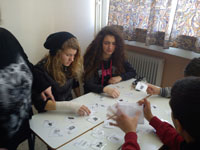
production: finding
alternatives to power
conventional electrical
appliances
Image courtesy of Vasiliki
Kioupi
Following that training, Vasiliki set up a two-month project in her classroom to investigate the structure and function of DNA. “Using web-based databases is an incredibly motivating and effective tool to demonstrate genetics concepts. My students were able to compare sequences and understand how DNA folds, replicates and translates, using real scientific data,” Vasiliki explains. “They felt like true scientists and were instinctively more motivated by the lessons because they were using real data.”
Vasiliki was also teaching chemistry and physics, so she set up other projects in these subjects, including an experiment to investigate the production of sustainable energy. During a year-long project, her classroom built an electricity plant based only on solar and wind energy. The electricity that they produced was used to power a station that recorded the temperature and humidity of the air.
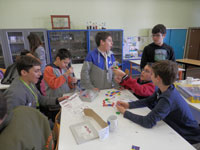
biology course
Image courtesy of Vasiliki
Kioupi
In the first half of 2014, Vasiliki also got her students involved in the E-CLIC Competitionw4. This European initiative aims to promote landscape preservation among younger citizens, to enable them to get involved in policy development and to assess the impact of these policies. Her environmental education group submitted a proposal on how to make their school more environmentally friendly and use its resources in a more sustainable way. The results of the competition are due soon.
Such enquiry-centred projects are very popular with students because they feel involved and can get something tangible out of it. “It is also very rewarding for the teacher. Part of why I like my job so much is because I can create a special relationship with the students and I get this immediate feedback on what I do. It can be good, or sometimes not so good, but you immediately feel how things are going and you can adapt,” says Vasiliki. “It pushes you to be at your best all the time.”
Story-telling teaching model
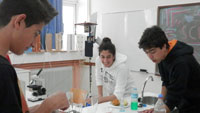
contest ‘Experiments in
Biology, Chemistry and
Physics’
Image courtesy of Vasiliki
Kioupi
Such human interactions influence progress on more than one level. Science doesn’t develop on its own, independent of any context: it is done by people, and very often influenced by the society in which they exist. Understanding this human aspect is important, so the VMES team started testing the story-telling teaching model in 2014.
Students watch videos on important scientific discoveries that are presented in a narrative: the focus is put on the scientists that made the discovery, how they thought and approached their research subject, what method they used, and how their societal background influenced their decisions. Following the screening, students answer questions, carry out activities and perform research on the worldwide web to complement their understanding of both the scientific concept and the context in which it was discovered.
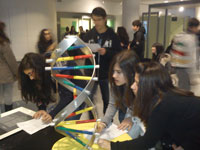
function: students visiting an
interactive science portal to
collect initial data
Image courtesy of Vasiliki
Kioupi
One of these videos, for example, tells the story of the Scottish physician James Lind, who discovered the cure for scurvy. Lind was the first person to conduct a clinical trial to test various hypotheses on the treatment of the disease that afflicted mostly sailors in his time. The corresponding educational activity first asks the students to identify and research the most important facts about the discovery and the disease itself. They are then asked to design and conduct their own experiment to find a solution to a real-life problem similar to the one that Lind faced.
Collaborations
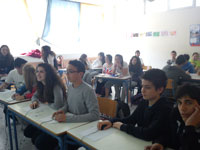
function: evaluation using
ICTs
Image courtesy of Vasiliki
Kioupi
A large part of these new teaching methods relies on collaborations between students: they need to work in a team to solve problems and overcome challenges. Similarly, collaborations between like-minded teachers, or schools, can provide real added value to the lesson and the scope of the students’ observations and analyses. Some projects, for example monitoring the environment in a specific area, can become much more comprehensive and interesting if several groups collect and share data and schools establish collaborations with research institutes. For this reason, Vasiliki is now taking on a new role as a teacher trainer and counsellor in Athens.
With a focus on the environment and sustainable development, she will set up projects with and for colleagues in and outside the classroom. After careful evaluation, successful projects will be communicated to a wider audience through a network that Vasiliki will co-ordinate. By being responsible for different schools over a wide area of Athens, she also hopes to be able to set up collaborative initiatives, such as a sea-water monitoring project. By using what she has learnt as a science teacher over the years, she is communicating science to an even wider audience – essentially building an even bigger ‘classroom’.
Web References
- w1 – The Varvakeio Model Experimental School has a website dedicated to its middle school, and another one for its high school. (in Greek only)
- w2 – Learn more about the European Learning Laboratory for the Life Sciences (ELLS), and its various project for science teachers.
- w3 – The European Bioinformatics Institute (EBI) hosts several important biological databases that you can visit on their website.
- w4 – Find out more about the E-CLIC Competition on its website.
Resources
- Vasiliki Kioupi has a blog full of interesting information, dedicated to science teachers and students (in Greek only).
- Vasiliki is the current ELLS Visiting Teacher and is collaborating with the EMBL ELLS to co-organise an ELLS LearningLAB in Athens. Keep an eye on the ELLS LearningLABs announcement page to stay informed about next ELLS courses and registration deadlines.
- This article explains how you can do bioinformatics with just a pen and paper:
- Kozlowski C (2010) Bioinformatics with pen and paper: building a phylogenetic tree. Science in School 17: 28-33.
- Check out this article to find a detailed lesson plan using a biological online database:
- Tenorio G (2014) Using biological databases to teach evolution and biochemistry. Science in School 29: 30-34.
Review
The article was very interesting. I found a lot of analogies between the system used here and the old Nuffield Learning approach used in the UK.
Dr Terry Myers, Banbridge Academy, Northern Ireland





